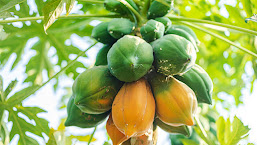Understanding Papaya
Before diving into the planting process, it is crucial to
understand the papaya plant itself. Papayas are fast-growing, herbaceous plants
that can reach a height of 10 to 12 feet within a year under optimal
conditions. The fruit, which can be eaten raw or used in numerous dishes, is
rich in vitamins A, C, and E, as well as dietary fiber and antioxidants.
Papayas thrive in tropical and subtropical climates, where temperatures range
between 70°F and 90°F.
Choosing The Right Variety
There are several varieties of papaya, each with its unique
characteristics. The two main types are the Hawaiian and Mexican papayas.
Hawaiian papayas are smaller, typically weighing about 1-2 pounds, and have a
sweeter taste. Mexican papayas, on the other hand, can weigh up to 10 pounds
and have a milder flavor. Your choice of variety will depend on your climate,
soil conditions, and personal preferences.
Site Selection
Papayas require a location with full sun exposure and
well-drained soil. They do not tolerate waterlogged conditions, which can lead
to root rot and other diseases. Ideally, the planting site should have a slight
slope to ensure good drainage. Additionally, papayas are sensitive to strong
winds, so a sheltered location or windbreaks can help protect the plants.
Soil Preparation
Papayas prefer slightly acidic to neutral soil with a pH
range of 6.0 to 7.0. Before planting, conduct a soil test to determine the pH
and nutrient levels. Based on the results, you may need to amend the soil with
lime to adjust the pH or add organic matter to improve fertility. Well-rotted
compost or manure can enhance soil structure and provide essential nutrients.
Planting Papaya
Papayas can be grown from seeds or transplanted seedlings.
Growing from seeds is more common and cost-effective. Here’s a step-by-step guide
to planting papaya seeds:
- Seed Selection: Choose seeds from a ripe, healthy papaya. Wash the seeds to remove the gelatinous coating and let them dry in a shaded area for a few days.
- Germination: Plant the seeds in seed trays or small tubs filled with a well-draining potting mix. Sow the seeds about 1/2 inch deep and water gently. Keep the soil moist but not waterlogged. Seeds usually germinate within 2-3 weeks.
- Transplanting: Once the seedlings have grown to about 8-10 inches tall, they are prepared for transplanting. Space the plants about 6-10 feet apart to allow sufficient room for growth and air circulation.
- Planting: Dig a hole slightly larger than the root ball of the seedling. Place the seedling in the hole, ensuring that the root crown is level with the soil surface. Backfill with soil and water thoroughly.
Watering And Fertilization
Fertilization is vital for healthy growth and fruit
production. Apply a balanced fertilizer with equal parts nitrogen, phosphorus,
and potassium every 4-6 weeks. Organic options such as compost or fish emulsion
can also be beneficial. Additionally, micronutrients like magnesium, iron, and
zinc can be supplemented if deficiencies are noted.
Pest And Disease Management
Papayas are susceptible to various pests and diseases,
including aphids, spider mites, whiteflies, and fungal infections like
anthracnose and powdery mildew. Regular monitoring and early intervention are
crucial for effective management.
Use integrated pest management (IPM) strategies to control
pests. This includes cultural practices such as crop rotation, biological
controls like beneficial insects, and, when necessary, chemical treatments with
insecticides or fungicides.
Harvesting And Post-Harvest Handling
Papayas typically start producing fruit within 9-12 months
of planting. Harvest the fruit when it shows signs of ripening, such as a
change in skin color from green to yellow. Handle the fruit carefully to avoid
bruising.
After harvesting, papayas can be ripened at room temperature
or refrigerated for extended storage. Proper post-harvest handling, including
cleaning and grading, ensures the fruit remains fresh and appealing to
consumers.
Conclusion
Planting papaya can be a fulfilling endeavor, providing a
bountiful supply of delicious and nutritious fruit. By understanding the
plant’s wants and following best practices in site selection, soil preparation,
planting, and care, you can enjoy the rewards of a thriving papaya garden or
orchard. Whether you are a novice gardener or an experienced farmer, the
journey of growing papayas offers a blend of challenges and joys that culminate
in the sweet taste of success.



.jpeg)

.jfif)
No comments:
Post a Comment